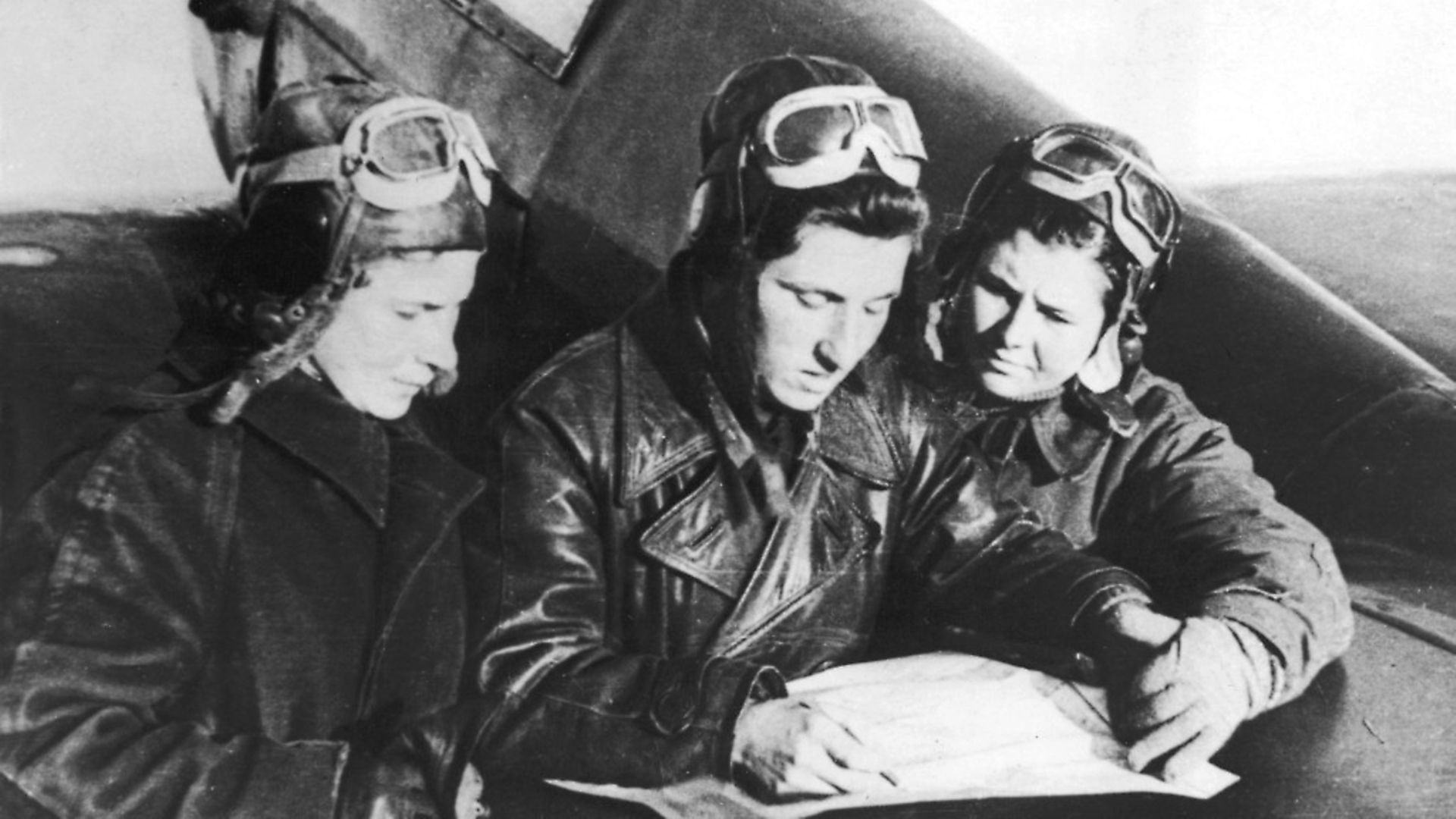On the afternoon of August 1, 1943, Lydia Litvyak was heading back to the Soviet airbase at Krasnyi Luch in south-eastern Ukraine after a sortie escorting a squad ground attack planes taking part in the vicious fighting on the Eastern Front.
It was her fourth mission of the day and the 268th combat flight of a career that was barely a year old.
Just when she thought her work was done, a group of 30 Junkers Ju-88 German bombers loomed out of the haze, escorted by a dozen Messerschmitt Bf 109s. As Litvyak, three weeks shy of her 22nd birthday, broke formation to attack them, two of the fighters immediately turned on her. She heaved her plane around to confront them and shot one of them down – the 12th solo kill of her career – before the dogfight that followed disappeared into a bank of thick cloud.
The clouds parted briefly a short while later allowing fellow pilot Ivan Borisenko a glimpse of Litvyak’s Yak-1 belching smoke and being pursued by up to eight Messerschmitts before the white mist closed around them once more. Lydia Litvyak was never seen again.
Around 800,000 Soviet women volunteered for combat in the battle against Nazism, serving in roles from tank driver to sniper, keen and willing to fight for the nation that would suffer more casualties during the conflict than any other. That Lydia Litvyak, also known as Lilya, came to stand out among so many exceptional women is testament to her skill as a flyer, her panache as a fighter ace and the burning sense of injustice that stoked her courage.
That courage was legendary even within her own short lifetime. Five months before her final mission Litvyak had been seriously wounded after engaging with six German fighters escorting a squadron of Ju-88s. Having succeeded in shooting down one of the bombers, Litvyak became aware of a searing pain in her leg. Two Me109s had closed on her and a bullet had zinged through the Yak-1’s flimsy airframe to pierce her thigh. As the pain zinged through her body four other Me109s arrived, leaving her outnumbered by six to one, badly injured and flying a damaged aircraft.
Instead of attempting to outrun her pursuers she turned and flew straight at them, gambling that the Germans would take evasive action. Her nerve held and the German fighters veered away, leaving Litvyak enough time to shoot down one of them before escaping to her base. So bad were her injuries that while she managed to land the plane successfully, by the time it had rolled to a halt on the runway she was unconscious. She was back in the air within a fortnight.
Lydia Litvyak didn’t look like a fighter pilot. She was small enough to need cushions on her cockpit seat in order to see out of the windows and there were wooden blocks on the rudder pedals because her feet wouldn’t reach them otherwise. She was also very much her own woman from the moment she enlisted, refusing initially to have her long brown hair cut like the other recruits, then dying it electric blonde with hydrogen peroxide obtained for her by her mechanic, Inna Pasportnikova.
She would accessorise her bland uniforms with colourful scarves made from the discarded parachutes of downed PoWs and place wild flowers in the cockpit of her aircraft before every mission.
At Litvyak’s first morning roll call, Pasportnikova recalled after the war, once the women had lined up for inspection, their trainer and commander, the pioneering aviator Marina Raskova, barked at Litvyak to step forward. The women’s winter uniforms came with a standard brown fur collar but Litvyak’s was garnished in fluffy white: she had cut the goatskin lining out of her boots and attached it to her jacket.
“What on earth is that around your shoulders?” Raskova bellowed.
“A goatskin collar,” came the calm response. “Why, don’t you think it suits me?”
Moscow-born Litvyak had always dreamed of being a pilot and enrolled at a flying club at 14, making her first solo flight within a year. When the Germans invaded in the autumn of 1941 and the call went out for the Russian people to rally to the cause she was one of the first to sign up, out of patriotism certainly, but there was also a deeply personal reason for Litvyak to demonstrate she was a loyal Soviet citizen.
One day in 1937 her father Vladimir, a train driver turned low-level bureaucrat at the People’s Commissariat of Transportation, never came home. The Stalinist purges were at their height and Vladimir Leontovich Litvyak had become one victim among millions. Nobody knew what he had done to incur the wrath of officialdom – it would take until 1956 for the family even to learn that he had died of a heart attack in prison in 1943 – but the ripples that emanated from Vladimir’s disappearance left the rest of the family tainted by association. Lydia saw serving her country when it needed her most as a way to both restore the family name and honour her father.
It was also a logical progression as a member of the first Russian generation to live their life wholly under communist rule: she was first a Little Octobrist, then a Young Pioneer, then a member of the Party’s youth wing the Komsomol before, in 1941, she joined the all-women Aviation Group 122 founded by Raskova, seeing combat for the first time in the summer of 1942 over the city of Saratov.
Her first kill came as a member of the 437th Fighter Unit on 13 September that year, a Ju-88 bomber over Stalingrad, followed the same day by a Bf 109 fighter on the tail of her squadron leader Raisa Beliaeva, making Litvyak the first woman pilot ever to shoot down an enemy aircraft.
The Bf 109 was piloted by German ace Erwin Maier, who parachuted from the aircraft into captivity where he was immediately introduced to the tiny young woman who had just ensured he would sit out the rest of the war in a prison camp.
Inconveniently for Litvyak and the pilots she flew with most often, Yekaterina Budanova, Maria Kuznetsova and Beliaeva, the 437th didn’t have the necessary ground support to service their preferred Yak-1 aircraft so, in October 1942, they moved again, this time to the highly-regarded 9th Guards Fighter Unit and then, in January 1943, to the 296th Fighter Regiment. There Litvyak was awarded the Order of the Red Star and made an okhotniki, or ‘free hunter’, exceptional pilots permitted to actively seek out enemy aircraft rather than simply respond to hostile incursions.
For all her astonishing bravery, Litvyak nurtured one fear. It certainly wasn’t death, whose nose she tweaked every time she took to the skies, the dread that lurked within her was the possibility of going missing in action. Screaming out of the heavens in flames and smashing into the ground in a fireball was a risk she was more than prepared to take, but if she disappeared, ditching in enemy territory, for example, to be captured or executed, that was a different matter.
Being listed as ‘missing in action’, in the midst of intense Stalinist paranoia, carried with it an association with treachery and such combatants would always be suspected of cowardice or, worse, defection. Not least a pilot whose father had been declared an ‘enemy of the people’.
Litvyak’s fate was exactly the one she dreaded most. Nobody in the USSR had seen her crash or knew what had become of her, whether she was dead or in an enemy prison camp. It speaks volumes for the regard in which she was held that Pasportnikova, the loyal mechanic, spent nearly four decades after the war searching for the truth about that day in 1943.
Having investigated nearly 100 Second World War crash sites, in 1979 she found a grave in a remote village where locals recalled a woman pilot had been buried after being killed in a crash during the war. Examination of the remains led a special commission to conclude that they were those of Litvyak, finally allowing her to be awarded the title of Hero of the Soviet Union. Strong rumours still circulate that she was captured (even that she stayed in Germany, married a Swiss man, had three children and lived well into old age), but the likeliest explanation remains that the 21-year-old died among the long shadows of that late August afternoon in 1943.
“Of course I want to live, if only a little, but it has to be a life that’s wild and interesting,” she’d written to her mother shortly before her death. “The hour will soon come when we shall soar on the wings of hawks, and the life we live will be very different.”












